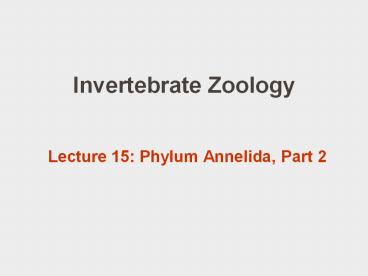Invertebrate Zoology - PowerPoint PPT Presentation
Title:
Invertebrate Zoology
Description:
Nervous system/Sensory structures. Class Polychaeta. Class Clitellata next time... Nervous System: sensory organs. Class Polychaeta. A variety of tactile ... – PowerPoint PPT presentation
Number of Views:1711
Avg rating:3.0/5.0
Title: Invertebrate Zoology
1
Invertebrate Zoology
- Lecture 15 Phylum Annelida, Part 2
2
Lecture outline
- Phylum Annelida, Part 2
- Circulation/gas exchange
- Osmoregulation/excretion
- Nervous system/Sensory structures
- Class Polychaeta
- Class Clitellata next time
3
Circulation/gas exchange Overview
- Why do members of Phylum Annelida need a
circulatory system?
4
Circulation/gas exchange Class Polychaeta
- Closed circulatory system
- Key gas exchange sites
- Parapodia
- Additional structures (some)
- Anterior gills (Terebellidae)
- Tentacular crown (Sabellidae)
- Body surface
- If no other structures
5
Circulation/gas exchange Class Polychaeta
- Two major vessels
- Dorsal blood ? anteriorly
- Ventral blood ? posteriorly
- Extensive capillary beds in
- Parapodia
- Other gas exchange structures
- Anterior and posterior
- Intestine
- Blood moves between main vessels via
- Capillary beds
- Segmental vessels (ring vessel)
6
Circulation/gas exchange Class Polychaeta
7
Circulation/gas exchange Class Polychaeta
- No hearts
- Movement of blood via vessel contraction body
wall contraction - Respiratory pigments
- Primarily dissolved within plasma
- Primarily hemoglobin
- Two forms of hemoglobin for polychaetes in
potentially low-oxygen environments - How do these two forms differ? Adaptive value?
8
Circulation/gas exchange Class Polychaeta
- Terrebellidae circulatory system
9
Circulation/gas exchange Class Clitellata,
Subclass Oligochaeta
- Closed circulatory system
- Organization similar to Polychaeta
- Key differences include
- Subneural vessel (so 3 main vessels)
- More highly-developed pumping structures
- Large, muscular dorsal vessel
- 2-5 pairs of enlarged circumesophageal vessels
- One-way valves prevent backflow
- Key respiratory surface is the epidermis
- Must stay moist. Why? How?
10
Circulation/gas exchange Class Clitellata,
Subclass Oligochaeta
11
Circulation/gas exchange Class Clitellata,
Subclass Hirudinoidea
- Combination of the ancestral annelid
circulatory system reduced coelomic spaces. - Sometimes reduced coelomic passages only
- Blood movement via vessel body wall contraction
12
Osmoregulation/Excretion Class Polychaeta
- Protonephridia or metanephridia (many)
- Often associated with coelomoducts
- What is it?
- Function?
- Nephridia and coelomoduct linked in different
ways - Osmoregulatory excretory
- Fluid entry ? selective reabsorption along tube
13
Osmoregulation/Excretion Class Clitellata,
Subclass Oligochaeta
- Metanephridia
- Fluid entry
- Via coelom
- Nephrostome
- Via circulatory system
- Capillaries
- Specialization of regions
- Such as..?
14
Osmoregulation/Excretion Class Clitellata,
Subclass Hirudinoidea
- Metanephridia
- Nephrostome connected to a capsule with amoeboid
cells - Function?
- Intracellular duct system
- Temporary
- Formed by coalescing intracellular vacuoles.
15
Nervous System Class Polychaeta
- Dorsal brain within prostomium
- What happens if brain is removed?
- Anterior sensory structures connect with brain
- Often a variety of tentacles, etc
- Circumenteric connectives to ventral nerve cord
16
Nervous System Class Polychaeta
- Paired, fused ventral nerve cords
- One ganglion per segment
- Lateral nerves ? pedal ganglia
- Giant axons
- Why giant? Function?
17
Nervous System sensory organs Class Polychaeta
- A variety of tactile and chemoreceptors
- Anterior nuchal organs
- Ciliated pits
- Chemosensory
- Dorsal cirri of parapodia
- Tactile, chemosensory
- Also for gas exchange
Photos www.tolweb.org
18
Nervous System sensory organs Class Polychaeta
- Photoreceptors
- Simple pigment cup (Chaetopteridae)
- Pigment cup with lens (Nereidae)
- Complex eye with cornea, lens and retina































